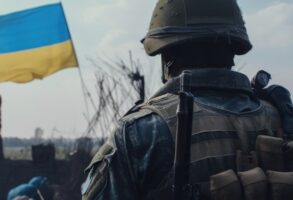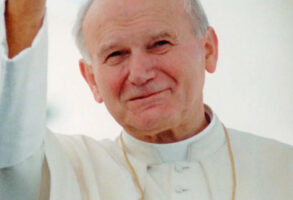
Published July 13, 2015
Cracow — Perhaps it’s because I’ve been living in the city John Paul II called “my beloved Cracow” for the past two and a half weeks, but it does strike me (and not only me) that the contemporary Vatican seems to have forgotten some crucial lessons from the teaching and diplomacy of the saint who came to Rome from Cracow and became the most consequential pope of the second half of the second millennium.
Let’s begin with the diplomacy — or, to put it better, with the Bishop of Rome as the Catholic Church’s leading public witness.
John Paul II’s first pastoral pilgrimage to Poland in 1979 is rightly regarded as one of the key turning points of the Cold War, because it ignited the revolution of conscience that made possible the Revolution of 1989 in its unique form. But many here in Cracow also carry vivid memories of John Paul’s second pastoral visit to his native land, in 1983, which took place under very difficult circumstances. Martial law was still in force; the Polish state, under General Wojciech Jaruzelski, continued to act like an occupying army, stifling Polish civil society; the bright hopes of Solidarity, a movement of national renewal as well as a trade union, seemed dust and ashes.
When John Paul II arrived in Poland on June 16, 1983, he did not embrace General Jaruzelski or other Polish state authorities; rather, during the opening ceremonies he looked down, sorrow and concern inscribed on his expressive face. An elderly woman, seeing him like that, said, “You see? He understands. He is sad.” When John Paul met Jaruzelski one on one, those outside the room said later that they could hear fists being pounded on the desk between the two men; John Paul reportedly opened the conversation by saying, “I have the impression that this country is one vast concentration camp” — a reference to the Polish experience under Nazi occupation that cut very deeply indeed.
Then there were the papal visits to Chile in 1987 and Paraguay in 1988: two culturally Catholic countries beset by military dictatorships. The confrontations with General Augusto Pinochet and General Alfredo Stroessner took place behind closed doors. But less than two years after the papal visit, Pinochet agreed to a plebiscite in which his people voted him out of power. Events moved even faster in Paraguay as Stroessner, the world’s longest-lived dictator at the time, lost power in 1989 after a 35-year rule. Those democratic transitions, like all such affairs, were complicated in their causation. But it surely made a difference that John Paul II did not concede the inevitability of authoritarian rule (insisting to Pinochet that his people had a right to their liberties, even if they misused them). And perhaps more to the point, he acted in such a way as to give heart and new hope to the democratic opposition in both Chile and Paraguay.
And then there was Cuba in 1998. Far too shrewd to get into a public brawl with that rhetorical volcano, Fidel Castro, John Paul instead adapted the tack he had taken in Poland in 1979. After the normal courtesies, he ignored the Cuban regime and its claims to embody justice and tried to give back to the people of Cuba their culture, which the Castro regime had brutalized, and their authentic history, which the Castro regime had rewritten. The most striking example of this was John Paul II’s address at the University of Havana, where, with Fidel Castro in the audience, he reminded the representatives of Cuban intellectual and cultural life that it was the island’s historical Catholic faith that had forged “Cubans” out of a striking admixture of native peoples, Spaniards, and Africans. And it was that same Catholic faith, he continued, that had inspired many of the liberators of Cuba (including the heroic Father Félix Varela, whose example would inspire a post-papal-visit human-rights initiative on the island prison) to throw off the shackles of colonialism.
This substantively robust but tactically deft approach to dictatorships of the Left and Right was an implicit challenge to the diplomacy of Cardinal Agostino Casaroli, architect of the Ostpolitik of the Vatican from the mid 1960s until 1978, when John Paul was elected. Casaroli was often dubbed the “Kissinger of the Vatican” by the world media. In fact, he was far more the Willy Brandt of the Vatican: He believed that the Cold War division of Europe was as permanent a fixture of world politics as anything ever is; he hoped that a more accommodating approach by both the Church and NATO to the Soviet Union and the Communist regimes of the Warsaw Pact would facilitate a process of “convergence” in which a slowly liberalizing East and an increasingly social-democratic West would draw closer over time; and he expected that, through such a long process of political-economic evolution, the Wall would eventually come down.
Cardinal Casaroli had highly developed diplomatic skills and a lot of contacts behind the old Iron Curtain. Moreover, he embodied a tradition of Vatican diplomacy in which the Holy See imagined itself as the honest broker among the powers of Europe; at times, it sometimes seemed as if Casaroli imagined himself a 20th-century Cardinal Ercole Consalvi, the skillful papal diplomatic agent at the Congress of Vienna. But John Paul II, who knew Communism and Communists a lot better than Casaroli did, wasn’t buying the Casaroli Project, and he wasn’t about to let Casaroli circumscribe his own papal field of action.
John Paul was wily enough to let Casaroli continue his diplomacy behind the Iron Curtain, so that the Communist powers couldn’t publicly accuse this Pole of reneging on previous deals and acting as a front for NATO. Yet while he never would have put it as Ronald Reagan did when the future president said that his idea of ending the Cold War was that “we win and they lose,” the Polish pope knew that this was indeed a zero-sum game: Someone was going to win and someone was going to lose, not so much for reasons of power but because Communism was based on a false understanding of the human person, human community, human origins, and human destiny. And by restoring to his own Polish people the truth about themselves, John Paul II helped them forge tools of liberation that Communism could not match, while reinforcing the similar strategy of resistance by “living in the truth” that was being deployed by secular, anti-Communist human-rights activists such as Václav Havel, using what Havel famously called “the power of the powerless.”
The people in charge of Vatican diplomacy today seem to have missed all this or forgotten all this — or are, perhaps, deliberately ignoring it (not least because of the overwhelming archival evidence that the most important concrete effect of the Ostpolitik was to open the Vatican to serious penetration by Warsaw Pact intelligence services, an unhappy fact I thoroughly documented in the second volume of my John Paul II biography, The End and the Beginning). Those guiding the Holy See’s interface with politics today were born and bred in the Casaroli School. And they are busily replicating Casaroli’s accommodationist (or, if you prefer, less confrontational) formula. This seems clear, if unfortunately clear, in the Vatican’s diplomacy with Vladimir Putin’s Russia, and in the Holy See’s refusal to describe what is afoot in Ukraine as a gross violation of international law: an armed aggression by one state against another. It seems evident in the welcome that was afforded Raúl Castro in the Vatican several months ago. Now, to judge from the just-concluded papal visit to Ecuador, Bolivia, and Paraguay, Casaroli 2.0 seems to be informing the Vatican’s approach to the new authoritarians of continental Latin America.
I don’t believe for a minute that Pope Francis was pleased when President Evo Morales of Bolivia, one of the worst of the new authoritarians, presented him with a sacrilegious hammer-and-sickle “crucifix” at their exchange of greetings and gifts shortly after the Pope arrived in La Paz. But I can well imagine what the famously irascible Pope Pius XI would have done, had Joachim von Ribbentrop, foreign minister of the Third Reich, presented him with a swastika-crucifix; Herr von Ribbentrop would probably have had a pontifically inflicted dent in his thick skull. My point, however, is not that our Franciscan-inspired pope ought to have clobbered Morales with his “gift.” (If Pope Francis wanted to clobber anyone, he should have clobbered his spokesman for saying later that the gift was not “ideological.”) My point is that Casaroli 2.0, the Vatican’s new diplomacy of accommodation, has created circumstances in which a thug like Morales thinks he can get way with such a stunt.
And if Evo Morales, who is small beer as these things go, thinks he can get away with it, what are Raúl Castro and his colleagues in the Cuban Communist party and Cuban military thinking thatthey can get away with — eager as they are to use the pope to advance their hopes for a China-like transition in Cuba, in which they retain all political power while opening up the economy a bit, primarily to their own benefit?
There also seems to be a great forgetting in the Vatican about John Paul II’s teaching about economics, the nature of 21st-century poverty, and the empowerment of the poor. I have no problems whatsoever with recent papal and Vatican critiques of a technology-driven approach to economic life that is bereft of moral reference points and that ignores, when it does not undercut, the restraints on production and consumption imposed by a morally serious public moral culture. And I don’t like the kind of corporatism that sees the Boeing Company giving Bill Clinton a $250,000 honorarium for an hour or so of Clintonian hot air before depositing another large chunk of change in the slush fund known as the Clinton Foundation and underwriting a fundraiser for Hillary Clinton’s political action committee. I don’t like it when other corporations play this game, either, and I don’t imagine John Paul II would have thought this kind of corporatist back-scratching embodied his understanding of how the “free economy” should interact with democratic politics in the free and virtuous society of the 21st century — the outlines of which he offered in the encyclical Centesimus Annus (1991).
Moreover, today’s papal and Vatican emphasis on the problem of “exclusion” in the globalized economy would have resonated with John Paul II. After all, this was the pope who, on meeting Polish prime minister Hanna Suchocka for the first time, asked her a pointed question about exclusion. Suchocka had explained the bold decision of the now-governing Solidarity leadership, formed in trade unionism, to put the country through a form of economic shock therapy in order to ignite growth (which Poland has in fact enjoyed ever since); John Paul’s first question to the prime minister was, What would she and her colleagues do for those who fell between the cracks in this fast-forward transition?
Insofar as John Paul II had a political-economic worldview, he was a kind of conservative European social democrat. He was not a libertarian in any sense of the term; he believed that a vibrant public moral culture was necessary to discipline and temper the tremendous energies set loose by political and economic freedom, so that the net result was real human flourishing and the advance of the common good. On the other hand, he had a very low view of what might be called the “moral cash value” of the modern state. His experience, and his deep intellectual grasp of some important dynamics in political modernity, had taught him that the modern state, including the modern liberal state, had inclinations to a creeping totalitarianism — the phenomenon his successor, Joseph Ratzinger, would call the “dictatorship of relativism” (embodied in these United States by Justice Anthony Kennedy and his four lockstep colleagues on the port side of the Supreme Court).
For John Paul II, the state was an aggregation of necessary and important functions, the most important of which was the protection of the basic human and civil rights of citizens who enjoyed those rights, not as state-distributed benefits, but because of their inalienable human dignity. But he held by no means held a “sacral” view of the state, like some of his papal predecessors. And in the encyclical Evangelium Vitae (1995), John Paul, referring to states in which moral wrongs were deemed “rights,” described them as democracies in danger of becoming “tyrant-states.” Further,Centesimus Annus, his most developed explication of social doctrine, has a biting critique of social-welfare states that create welfare dependency.
Pope Francis, too, has criticized welfare dependency. But his commentary on economic matters, and that of his associates in the Roman curia, seems bound to a much higher view of the state’s moral cash value. Moreover, for all that John Paul and Francis share a profound concern for the “exclusion” of those on the peripheries of a globalized world economy, John Paul’s understanding of the nature of wealth and poverty today, and his prescriptions for remedying contemporary poverty, are very difficult to find in the work of the Pontifical Council for Justice and Peace, in the recent activities organized by the Pontifical Academy of Social Sciences, or in the formal texts prepared by the curia for Pope Francis’s use in Latin America.
John Paul understood that, in the post-industrial world, the real source of “wealth” is not so much “stuff” (land, resources, the “means of production”) as intelligence and imagination. Human wit and will, applied to the material world, turned hitherto useless stuff (like sand and dirt) into something very useful (silicon), thereby creating the engine of the greatest expansion of wealth creation in history (the IT revolution). In that kind of a world, poverty is indeed a matter of exclusion: exclusion from the networks where wealth is created and shared by the application of human imagination to stuff in the job-creating work of entrepreneurs. And the answer to that form of exclusion is inclusion, in the form of the empowerment of the poor, so that by the application of their talents, their intelligence, and their imagination, the poor can lift themselves and their families out of deprivation while liberating themselves from dependence.
John Paul II could “see” all that, both because he saw this kind of inclusion-through-empowerment as an expression of his basic concern (the dignity of the human person) and because he had taken the trouble to learn how the post–Cold War world economy actually works. I suspect he also looked at the great economic success stories of recent decades, such as those of the “Asian tigers,” and asked himself, “If Confucian cultures can underwrite this kind of empowerment, why can’t Catholic cultures?” And if he asked that question, one might further speculate, it was with Latin America in mind.
These John Paul II themes — wealth as the product of intelligence, imagination, and entrepreneurship; empowerment and inclusion as the core of serious anti-poverty programs — have been notably absent from recent Vatican commentary, as has John Paul’s insistence on the imperative of a public culture of honesty to make the free economy work. John Paul II knew that corruption was one of the primary reasons that Latin America was failing to fulfill its enormous potential. He also knew that the kind of systemic, culturally reinforced corruption that had turned Argentina from one of the world’s wealthiest countries into a bankrupt basket case reflected an enormous failure on the part of the Catholic Church, which had had 500 years to help build something better, something nobler, something more empowering — something more resonant with human dignity.
Cardinal Jorge Mario Bergoglio knew all this, too, in his days as archbishop of Buenos Aires. And in leading the Latin American bishops to put the re-evangelization of their continent at the center of their 21st-century concerns, the future Pope Francis was implicitly charting a course toward a very different future, one that seemed to take many of its reference points and intellectual touchstones from the teaching of John Paul II on the Church in the modern world and on the imperative of what John Paul called the “New Evangelization.”
Today, however, the Vatican’s institutional memory seems to retain little from either the teaching or the accomplishment of John Paul II. And that ill serves Pope Francis, whose public persona and popularity, like John Paul’s, create openings for real change to happen: change that leads to the empowerment and inclusion of the poor and marginalized. Such change seems unlikely, however, in circumstances in which Evo Morales thinks he can offer the first Latin American pope the dumbed-down, faux-Communist equivalent of Andres Serrano’s Piss Christ — and get away with it.
Thus the pope’s diplomats might want to spend Ferragosto, the summer period when the Vatican essentially shuts down, informing themselves about the failure of the Casaroli Project and studying the teaching of John Paul II on the free and virtuous society of the 21st century, as essential preparation for Pope Francis’s pastoral visit to Cuba in September, and to the United States after that.
— George Weigel is Distinguished Senior Fellow of Washington’s Ethics and Public Policy Center, where he holds the William E. Simon Chair in Catholic Studies.









